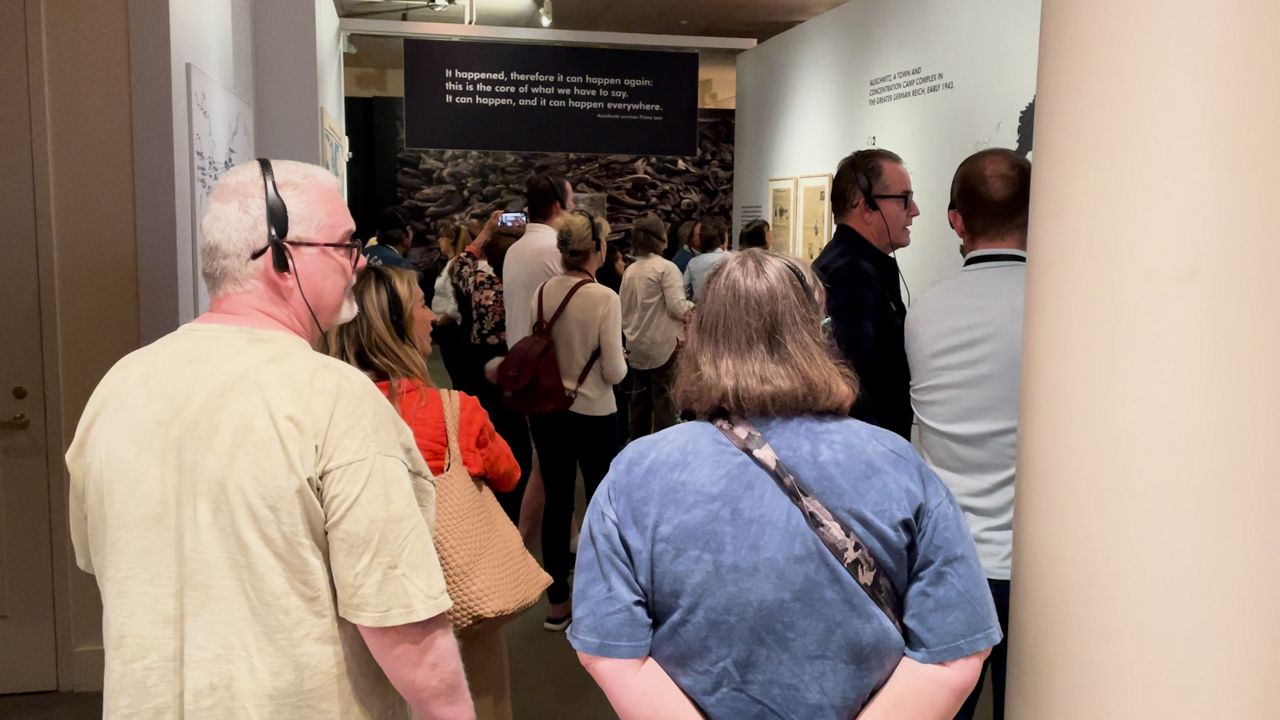SIMI VALLEY, Calif. — Before visitors even enter the exhibit at the Ronald Reagan Library in Simi Valley, they are met with their first iconic image of the Holocaust: a brown freight car.
“[It was] upwards of 80 people shoved into a train car for three to five days. No food, one bucket of water, one bucket for people to urinate in,” said Melissa Giller with the Reagan Library.
What You Need To Know
- The exhibit "Auschwitz: Not long ago, Not far away" opened on March 24
- It’s traveling to seven cities
- This is the fifth stop and the only one on the West Coast
- “Not everyone can go to Auschwitz and learn the story of Auschwitz and the Holocaust, so this exhibition brings that story to them,” Melissa Giller with the Reagan Library said
The exhibit, "Auschwitz: Not long ago, Not far away," opened on March 24.
“Auschwitz was actually chosen as the big killing camp because it had 44 parallel train tracks that all went into the camp,” Giller said.
When she and her team read an article about the exhibition in 2017, they knew they had to bring it here. It’s a two-level, 12,500 square foot audio tour that takes about two and a half hours to explore.
“Not everyone can go to Auschwitz and learn the story of Auschwitz and the Holocaust, so this exhibition brings that story to them,” Giller said.
It’s traveling to seven cities. This is the fifth stop and the only one on the West Coast. It features 700 artifacts with 400 on loan from the Auschwitz-Birkenau State Museum in Poland.
“You are seeing actual fence posts from the Auschwitz camps that were electrified to keep the prisoners inside,” she said.
She pointed out the bunks where the Nazis would put two, three, four, or five people per bunk, and since the deportees often had their heads and eyes downcast, Giller said many remember the Nazis’ black boots so vividly.
Other artifacts include items collected from the prisoners, the cauldron where the soup was made, parts from the crematorium the Nazis used to burn the bodies, and a replica of a gas chamber door.
“Because the people who were inside were clawing at the peephole, they created this mesh hole to go over it,” Giller explained.
“A lot of these items haven’t traveled together like this and when you’re in Auschwitz-Birkenau museum, you’re not seeing these artifacts because they belong in their archives, so they really are one of a kind that you don’t see anywhere else.”
As chilling as some of these items are, the stories behind them can be even more horrific, such as a manual detailing in German how to execute a prisoner.
“You put the prisoner at the edge atop of a ravine. You stand 10 meters away. You shoot your gun. The force of your bullet will push the dead body into the ravine,” Giller read.
Or the Red Cross truck depicted in a black and white drawing that prisoners thought was carrying medical supplies.
“What those trucks were really used for was to bring the gas cyanide to the gas chambers, so what they thought was there to help them was actually there to kill them,” Giller explained.

Among the visitors to the exhibit were 200 students on a field trip from Chaparral Middle School in Moorpark, where they had been learning about the Holocaust as part of their curriculum.
“To hear first-hand accounts and to see the actual artifacts, I want them to be able to make those connections and gain empathy from this experience,” said Alesandria Posada, a seventh and eight grade English teacher at the school.
It was an experience that wasn’t just about the Jews.
“It was the African Americans. It was the Asians. It was the Gypsies. It was the Romas. It was homosexuals. Hate ignored becomes the most vicious kind of hate,” Giller said.
She’s spoken with about a dozen survivors who have toured the exhibition. One of them passed along a message.
“I share my story so it becomes your story to share because I’m not going to be here much longer,” Giller shared.
It's a raw and powerful reminder of the need to speak up and fight hate where ever it lies.
Let Inside the Issues know your thoughts and watch Monday through Friday at 8 and 11 p.m. on Spectrum News 1.



